Employee engagement is defined as how much an employee is committed to helping their organization achieve its goals. It’s demonstrated by how employees think, feel, and act, as well as the emotional connection employees feel towards their organization, their work, and their team.
What is the problem with employee engagement?
Globally, only 21% of employees are engaged at work. Which means a whopping 79% of workers are probably watching the clock, counting down the hours until the weekend, and looking forward to their paychecks as the only good thing about their jobs.
According to Gallup, traditional workplace employee engagement strategies don’t work because:
- They’re seen solely as the remit of the HR department, rather than something to be owned by leaders, managers, middle management and frontline employees
- There are flaws in the programs themselves: the metrics measuring employee engagement are too complicated, or even wrong – making employee engagement appear high but not reflecting in business outcomes
- Employee engagement survey fatigue sets in with too many pulse surveys being sent out
- Lack of action in response to employee feedback
And while employee engagement is important, as we’ll see, it’s not the full picture. Employees can be engaged, and still:
- want to quit your organization
- struggle with unwieldy technology experiences and processes
- be at risk of burnout
- not feel like they belong
It’s no longer enough to measure engagement alone. As a metric, it doesn’t give you the full, holistic picture of your employees’ experiences at work on a day-to-day basis, and in real time. A business needs the full picture – the employee experience (EX) – to drive better business outcomes. You need to measure more than engagement, more often, and without adding to the workloads of already busy people.
Why is employee engagement important?
When you engage employees, they work harder, learn, grow and develop faster, solve problems, innovate, get along with their team members better and stay longer at your company.
Research shows:
Reductions in:
- Absenteeism (81%)
- Patient safety incidents (mortality and falls) (58%)
- Employee turnover for high turnover organizations (18%)
- Employee turnover for low turnover organizations (43%)
- Shrinkage (theft) (28%)
- Accidents (64%)
- Quality (defects) (41%)
Increases in:
- Customer loyalty / engagement (10%)
- Productivity (sales) (18%)
- Profitability (23%)
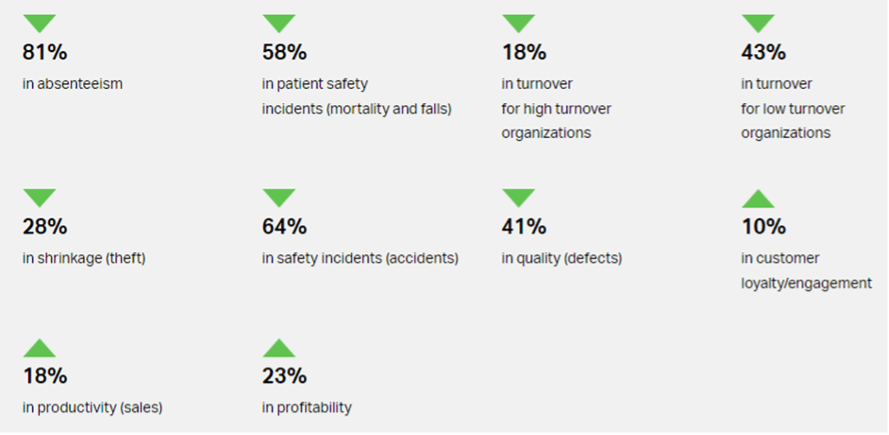
Image Source: Gallup
How to increase employee engagement
As we’ve seen above, when you increase employee engagement, great things happen within every aspect of your business.
According to our 2023 Global EX Trends Report there are three major areas to focus on to close experience gaps within your organization and engage employees more:
1. Feedback
As the saying goes, feedback is a gift. Before your employees can work to their full potential, develop new skills, innovate, serve customers better and get on with their teams, you need to identify what they need.
Employees crave feedback. Creating a company culture of end-to-end feedback helps employees to set an agenda for their work and their development – and keeps you aware of what you can deliver.
2. Invest in your people
It’s worth every cent. It’s essential you invest in your employees, and the place to aim the investment is at frontline workers who really are the beating heart of your company. These are the people who deliver for the business and are customer-facing, so they are the first to spot issues and trends, and pass them up the chain of command.
Investing in your people should be non-negotiable and one of the most important (and attractive) employee benefits. If you don’t start investing now, your valuable people will leave.
3. Live and breathe the company values
Nowadays, an organization’s mission and values, and how effectively and consistently they’re demonstrated, drive your employees’ intent to stay over the longer term. And being employed isn’t just about having a job any more – it’s now a part of a person’s whole value system.
When employees feel that their organisation’s values chime with their own values, they’re 27% more likely to have higher employee engagement scores, and 23% more likely to stay working for more than 3 years.
So how can you do these things in practical terms?
10 ways to improve employee engagement
1. Employees must know what’s expected of them
Actively disengaged employees often say that their roles and tasks have not been sufficiently delineated, and they are unsure what they are expected to do, or how far they can go to get the job done.
Solution: Implement a great onboarding process and experience for your new hires that sets out from the very first day what will be expected of them in their role. Encourage middle management to direct and support their new team members with one on one meetings. Ask new employees for feedback about their onboarding experience to gauge engagement levels.
2. Provide the right tools, tech, equipment, processes and systems to do a good job
The opposite of engaged employees is burnt-out employees. Our research found that more than a third (38%) of employees feel they’re burnt out, and that the top driver of employee burnout is ineffective processes and systems: computers that glitch, spreadsheets that take forever to load, out-of-stock products… you get the picture.
Solution: Listen to employees in real time so that problems with systems and processes are flagged the instant they happen. Then bring in the tech team to overcome adverse working conditions when things get busy or systems fail.
3. Inspire employees with great company mission and purpose
More and more, employees want to work for organizations that have integrity and purpose. At the same time, they crave growth and development opportunities that fulfill, challenge, and motivate them to be part of something bigger than just a paycheck at the end of the month.
Solution: Focus on your company’s mission and values, and assess how your processes
currently align with them. Build and cultivate a supportive work environment
with equal opportunities and the promotion of minorities into the leadership ladder to swell diversity. Promote people based on performance rather than tenure.
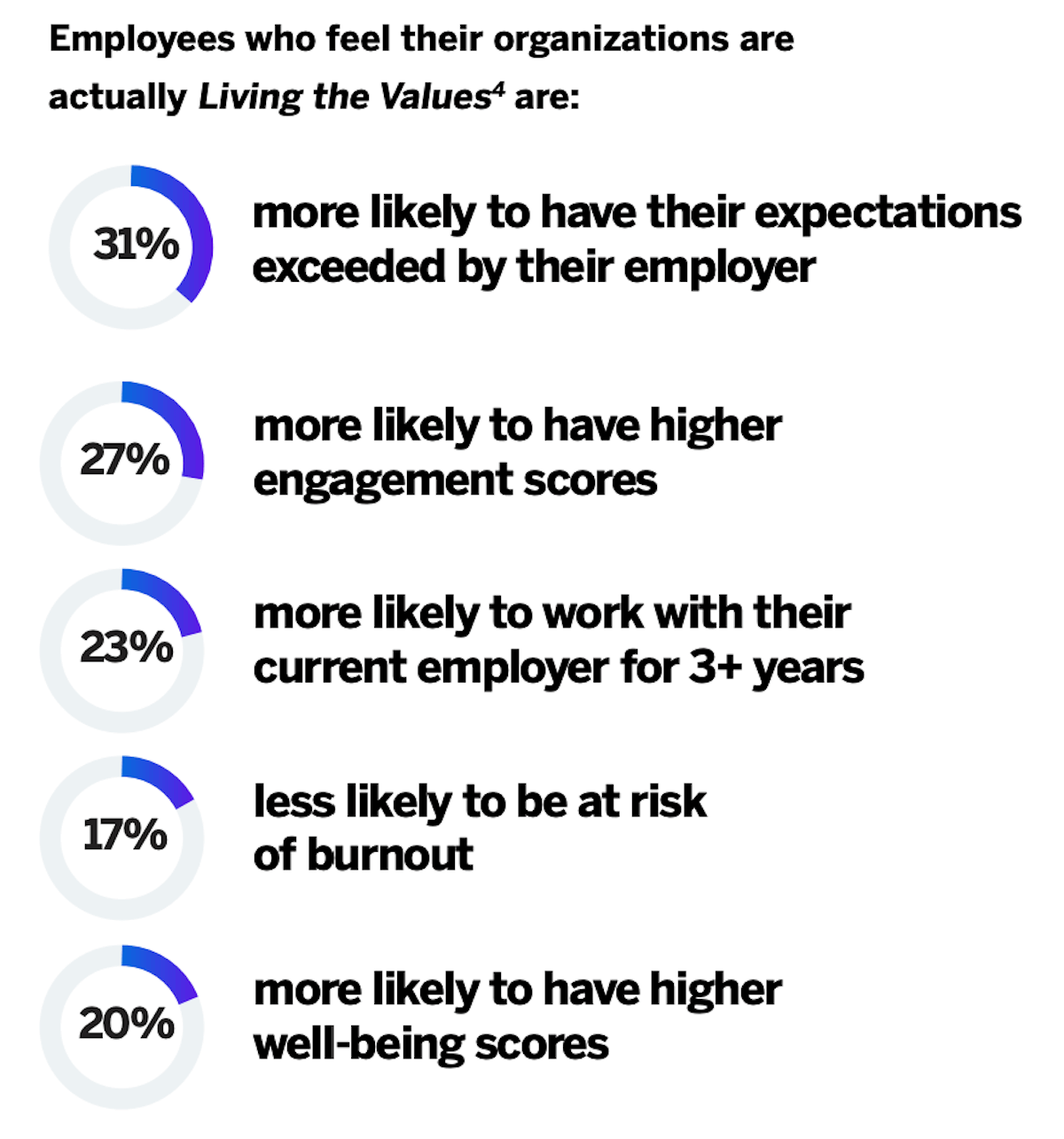
4. Encourage work life balance
The physical and mental health of your employees is paramount. And after years of operating at surge levels, employees are pushing back and reclaiming boundaries – often through quiet quitting. Going above and beyond one’s remit at work had become the expectation rather than the exception for many employees – who now want to reshape the relationship they have with work to set healthy boundaries, and thrive.
Solution: Check in on your employees’ mental and physical wellbeing and make sure they’re not overwhelmed; and it goes without saying that employees must be treated with respect at all times. Encourage employees to set flexible work schedules, and give them the option to choose their working hours to not only get the job done, but balance work and life and put less stress on families.
We found that when employees are empowered to achieve work life balance, they are more likely to contribute more to the organization. Of those who feel that they have a good work-life balance, almost two-thirds (63%) are willing to go above and beyond for their organization:
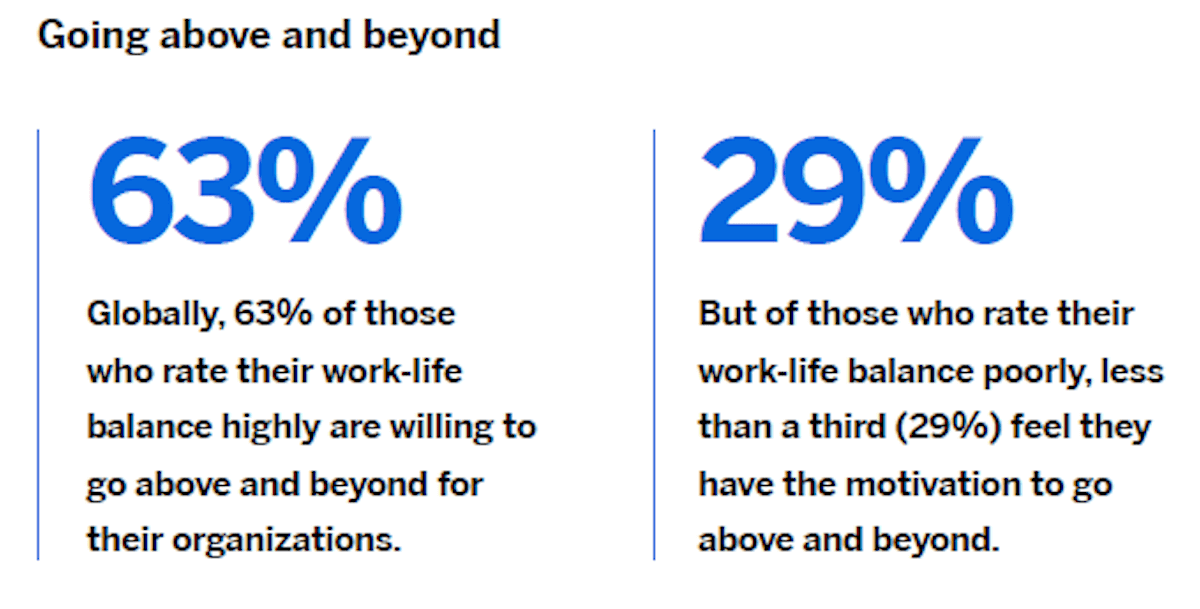
5. Inspire financial confidence in your workforce
The last few years of global upheaval, disruption, volatility and uncertainty have made job security and a decent salary a top priority for employees. Financial wellness is as important for maintaining employee engagement as physical and mental wellness.
Employees who are satisfied with their pay and benefits are 26% more likely to have their expectations exceeded at work, and 13% more likely to continue working with their current employers for 3+ years.
Employees simply want to know that the business they work for will continue to be a successful one into the future, and pay them a competitive salary. Our research found that only just over half (57%) of employees worldwide are satisfied with their current pay and benefits, and that satisfaction has dropped 10 points since last year.
Solution: Make sure your employees are remunerated and rewarded properly for their valuable contributions through tough times. Don’t let compensation fall behind market rates, and give generous employee perks that keep up with the current cost of living. Have open and transparent conversations about pay – this topic is no longer taboo.
6. Offer professional development opportunities
Employees crave growth and development opportunities that fulfill, challenge, and motivate them. Perhaps unsurprisingly, fewer people this year said they had good opportunities to learn and develop at work than in previous years:
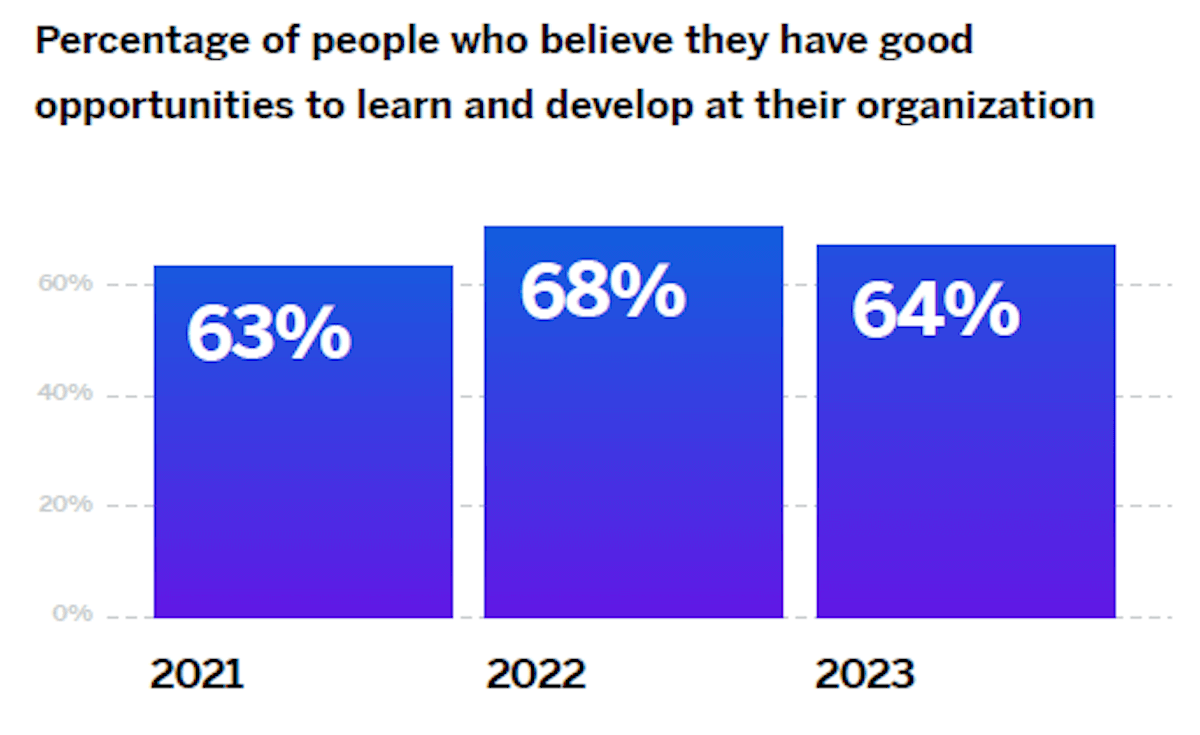
It’s essential that you see growth and development as an integral part of employee values. As an employer, you need to provide more than just access to proper training, development, and learning opportunities.Employees need the time and support to learn from it, which must come from leadership.
Ultimately, employees want to know how their efforts contribute to their own and company success. If they don’t, they’re much more likely to become disengaged.
Solution: Give new employees the opportunities to develop their skills, and set career development paths for all employees to progress into roles required for the future. Encourage managers to establish regular review sessions with their direct reports and team members to act on regular feedback. Keep everyone up-to-date on the business’s progress and what’s required for success.
7. Improve employee wellbeing
There’s a strong link between employee engagement and employee wellbeing. According to Gallup, employee engagement and wellbeing influence the future state of the other – i.e. they are reciprocal. They are also additive – each makes a unique, complementary contribution to employees’ feelings, behaviors, ideas, thoughts, and performance. In short, when your employee wellbeing suffers, so does employee engagement, and the business’s bottom line.
Your managers are your first line of defense regarding employee wellbeing. The best ones are tuned into employee sentiment and have the remit to provide employees with work schedules that balance work productivity with their life responsibilities.
Solution: Measure employee wellbeing in addition to your employee engagement surveys. You can do this with pulse surveys or with conversational analytics software. Train managers how to recognise burnout, approach wellbeing conversations with empathy, and show that they really care about their employees’ lives, both inside and outside work. You can also put in place a company wide wellness initiative that can range from discounted gym memberships to healthy food options in the canteen.
8. Create a great company culture of belonging
Workplace belonging is emerging as the top employee experience driver linked to employee engagement and wellbeing. When you foster belonging, you will improve employee engagement.
Employees who feel they belong say:
- There is open and honest communication in the company
- They feel they’re a valued member of the team
- They feel supported when adapting to organizational change
- They can be their authentic selves at work
- They believe that their company is one where everyone can succeed to their full potential, no matter who they are
Solution: Make sure your company has sound ESG initiatives – employees’ pride in making a difference plays a major role in fostering a sense of belonging. Make new employees welcome with a stellar onboarding experience that makes them feel part of the family from day one. And encourage employees to be their authentic selves at work. And as there’s no one-size-fits-all solution for fostering belonging in the workplace, just listen to what your individual people need – and then action their feedback to meet those needs.
9. Hire managers with inclusive leadership skills
Research by Deloitte found that teams with inclusive leaders are 17% more likely to say they are ‘high performing,’ 20% more likely to make better decisions, and 29% more likely to collaborate. A study by Catalyst found that 45% of experiences in an inclusive workplace could be explained by ‘managerial inclusive leadership’.
Clearly, leaders drive employee engagement. The best ones have the technical skills for the job, give regular recognition for a job well done, provide honest constructive feedback, and build and maintain great relationships with colleagues.
Solution: Make sure your employer brand is excellent so that top managerial talent wants to come and work for you. Give a great remuneration package. Continually train and develop your managers so they keep inspiring their teams.
10. Give generous employee recognition
We all love having a pat on the back when we’ve done a good job, and recognition is one of the most important drivers of good work:
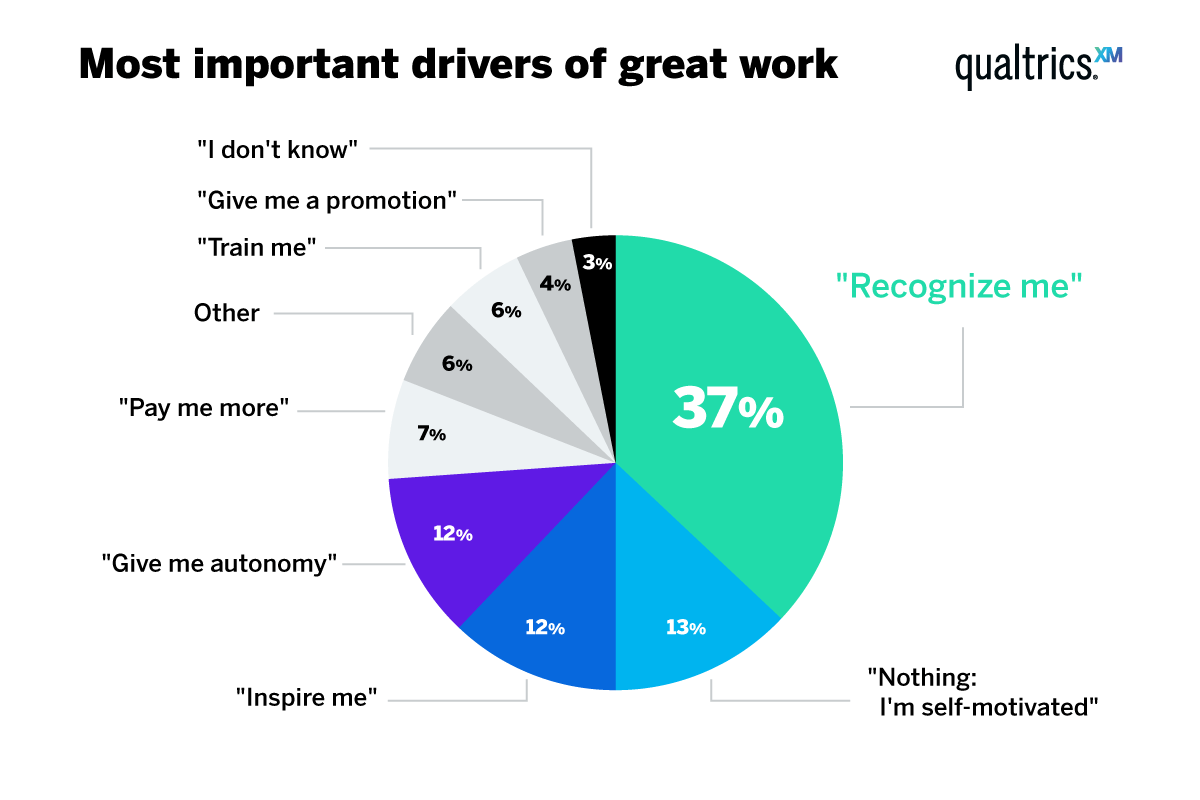
Organizations with a solid employee recognition strategy can expect higher employee engagement, better employee morale, improved customer service and lower employee turnover.
Companies that recognize and reward employees well can even expect 50% higher productivity and as much as a 20% increase in business outcomes.
Solution: Implement employee recognition programs. These could be:
- Years of service
- Customer service awards
- Employee appreciation events that celebrate achievements
- Monetary awards
- Employee of the Month or Year schemes (but make sure you don’t reward the same people all the time)
Go beyond engagement and create great employee experiences with Qualtrics
When you use the Qualtrics Employee Experience platform, everyone from new employees and shop floor workers to managers and the CEO can ensure their voice is heard. It’s the ultimate listening tool for gathering continuous feedback from every employee. You’ll be able to take the right actions to improve employee engagement, recognition, talent planning, productivity and innovation.
When you use Qualtrics, you not only have access to a whole raft of survey types to help improve the employee experience, including:
- Pulse surveys
- 360-degree feedback
- One on ones
- Employee engagement software
- Employee engagement surveys
You’ll also have access to the world’s most advanced conversational analytics, Qualtrics XM Discover. With omni-channel listening, you’ll hear every voice, even the quiet ones, to understand how employees feel about your company without even having to ask.
Improve employee engagement with Qualtrics